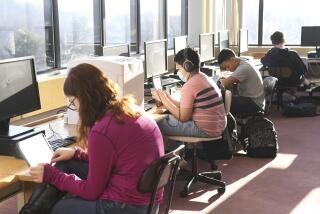Students’ Skill on Computers Found Lacking
- Share via
NEW YORK — Computer literacy is low among U.S. students because few have adequate access to the machinery, says a nationwide survey released Tuesday that also found minority members falling behind white students.
A majority of the 24,000 third-, seventh- and 11th-graders tested by the National Assessment of Educational Progress knew what a joy stick and a keyboard were but most had little or no working knowledge of computer functions or programs.
Despite the much-publicized, decade-old “classroom computer revolution,” most schools have yet to make effective use of computers to teach reading, math or science, says the 82-page report titled “Computer Competence: The First National Assessment.”
Among 837 school computer coordinators surveyed, the study found that 32% of third-grade coordinators, 23% of seventh-grade coordinators and 10% of 11th-grade coordinators did not feel adequately prepared to teach computer science.
Like Using Computers
More than 90% of third-graders and 86% of seventh-graders said they liked using computers and more than half said they wished they used them more.
However, a majority said they lacked adequate access to computers at school or at home. The report found also that school curricula have not changed to make effective use of computers and that most teachers are not adequately trained.
“The difference is between knowing a little about the computer and being able to use it effectively. Few American schoolchildren can do the latter,” said Marc Tucker, president of the National Center on Education and the Economy in Washington, who called the study results disappointing.
The National Assessment of Educational Progress is a project established 19 years ago by Congress to conduct national surveys of various educational skills. It is administered by the Educational Testing Service.
The assessment examined grade-school pupils across the country during the spring of 1986
More to Read
Sign up for Essential California
The most important California stories and recommendations in your inbox every morning.
You may occasionally receive promotional content from the Los Angeles Times.













